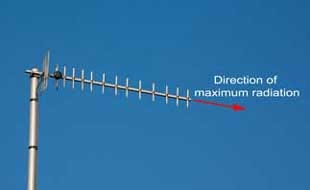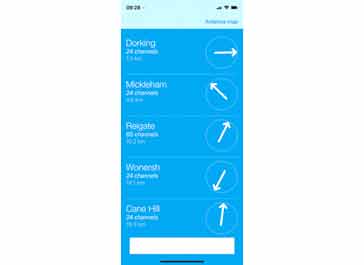What is a TV Antenna Direction Finder App
When installing a TV antenna, it is key to align or point the antenna in the right direction - a TV transmitter finder app can provide real help.
Home » Antennas & Propagation » this page
TV antennas guides include:
Types of TV antenna
Buying a TV antenna
TV antenna direction alignment & pointing
TV transmitter finder app
TV antenna alignment meter
Buying TV antenna amplifier / booster
Indoor TV antenna & set-up
Satellite TV dish installation
How to wire a TV antenna socket
Why doesn't a TV antenna work any more
General antenna installation guides
Antenna installation guide
Attic installation
Antenna height
When aligning a TV antenna, it is crucially important to direct it in the correct direction - if it points in the wrong direction, then the signal reception will be poor.
Point the antenna in the right direction, and the gain of the antenna can be used to give the best signal, and other unwanted transmitters that might cause interference can be reduced.

One way in which this can be achieved is to use a TV antenna direction finder app, or as some people may call them a tv transmitter finder compass direction finder.
With smartphones now owned by most people who might want to install a TV antenna, the apps that are available make this a very attractive option.
Why is orientation or pointing so important
It is really important to point the TV antenna towards the transmitter because the antenna will have a directional pattern which is sometimes called its polar diagram.

As a result, it will be much more sensitive to signals in one direction than another. If the most sensitive direction is not aligned towards the transmitter, then it will not pick up the best signal.
Whilst the gain in the main direction enables a much better television signal to be received, in others it is much reduced. This enables any interference to be reduced in level at the input to the television.
However, this directional pattern means that the antenna must be correctly aligned or orientated in the direction of the maximum signal, otherwise the performance will be reduced.
There are several methods that can be used to correctly orientate the television antenna. One of these is to use a TV antenna direction finding app - sometimes these may be called a tv transmitter finder compass direction app.
Smartphone TV transmitter finder apps
Smartphones are an ideal platform for a TV transmitter finder app. Most people have one and they normally incorporate all the sensors and processing power to be able to run a very good TV transmitter finding app.
They have access to the Internet for the database, they have GPS to provide a precise location and they also have a compass to enable the orientation and hence the direction to be determined.
With all these sensors and forms of connectivity they can become a very good TV transmitter finder compass, giving the distances and directions to local TV transmitters.
In fact there is a good selection of TV transmitter finder apps for both Android and a Apple iOS. Some are free, but others require a payment, and from experience this is typically quite small.
Often the paid apps tend to be slightly better, but it is worth looking at the reviews to check what is best.
Using the TV transmitter finder app
An app like this is normally very easy to download and set up the app on any phone - most are held either on the Google App Store or the Apple iOS app store.
Obviously Google for Android phones and iOS for any Apple phones - these are the main two platforms for smartphones so it is really one or the oter depending upon which type of phone is available.
Once the app has been downloaded and opened, it will check the location, and also the orientation of the phone.
Typically these apps display the direction to various transmitters giving the distance and orientation for each transmitter.
This will give a good indication of the transmitters in the locality that might give good service, although it won't take into account the topography of the area: any hills of buildings that might obstruct the direct line of sight path reducing or obliterating the signal.

Sometimes other information about the transmitters may be given - for example the number of channels each transmiter has, or possibly the transmitted power levels, etc.
The orientation given by the app, enables the TV antenna to be aligned in the right direction. In this way, the app provides can be termed a TV transmitter finder compass giving the direction for each station.
The various apps have a database of all transmitters and often they will work in most countries in the world, but it is worth checkin if there are any geographical restrictions.
Final adjustments
Although the TV transmitter finder app will give a very good indication of the line of sight direction to the transmitter, it is still possible that some further adjustment may be required.
One of the reasons for this might be that there could be a hill or building in the direct line of sight and as a result, the maximum signal may be coming from a slightly different angle as a result of diffraction, reflection etc.
Another reason may be to offset the antenna slightly fromt he optimum heading to reduce interference from another transmitter.

By offsetting the antenna slightly from the optimum heading, the strength of the interfering signal might be considerably reduced.
In many instances the direction given by the TV transmitter direction finding app will be exactly right for the situation, and there may be no reason to make an adjustment.
Bonus tips
When using a TV transmitter finder app there are a few points to note. Here are our tips and points to watch when using them.
Calibrate the smartphone compass: Although the compass facility in many smartphones is very good, it is worth checking the accuracy of them before using the TV finder app.
Sometimes these compasses can read inaccurately, especially if there is a magnetic part in the case or another magnetic item close to the phone. It is best to check the alignment of the phone before using it for any antenna alignment - there is generally a calibration feature within the smartphone.
Find out best local TV transmitter: Before aligning the antenna in any particular direction, it is always best to check which is most likely to be the best transmitter - the one that is most likely to give the best reception and the greatest number of channels, etc. Once selected, the antenna can be aligned with confidence.
Select the correct polarisation: Often different TV transmitters can use different polarisation - vertical or horizontal. Before setting up the antenna, make sure the correct polarisation is selected, otherwise signal levels will be very considerably reduced.
Check against other antennas: As a further check, it is always best to check against the direction of other TV antennas int he vicinity - this will give a good check whether the antenna being worked upon is being aligned in the general direction used by others.
These tips and guidelines will help ensure that once the antenna has been isntalled it will work to its best and there will not be the need to change the alignment after it has been installed.
TV transmitter finder applications for smartphones can be a very useful tool for assessing and even aligning television antennas when other methods are not feasible or available.
These apps can give a good indication of the stations available and the direction from the antenna. Often they may be the only way of assessing the right orientation for the antenna, although when feasible a signal strength meter can help make the final adjustments for the antenna to give th best performance.
 Written by Ian Poole .
Written by Ian Poole .
Experienced electronics engineer and author.
More Antenna & Propagation Topics:
EM waves
Radio propagation
Ionospheric propagation
Ground wave
Meteor scatter
Tropospheric propagation
Antenna basics
Cubical quad
Dipole
Discone
Ferrite rod
Log periodic antenna
Parabolic reflector antenna
Phased array antennas
Vertical antennas
Yagi
Antenna grounding
Installation guidelines
TV antennas
Coax cable
Waveguide
VSWR
Antenna baluns
MIMO
Return to Antennas & Propagation menu . . .



